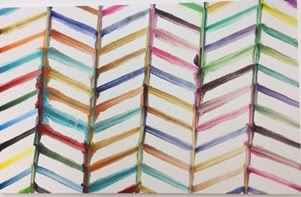 |
| Bernard Frize, Oma, 2007 |
One of the
most intriguing aspects is that the paintings are extremely difficult to
penetrate. They are filled with pretty colours, and therefore, very pleasing to
the eye, very easy to look at. But lingering in front of them, ironically,
leads frustration. This is partly due to the hardness of the reflective finish,
making them cold and completely without depth, thus not inviting contemplation
of any sort. But it is also about the
fact that the image reminds those of us with a desire for order and logic of a
geometrical or mathematical puzzle. Frize’s process of production – which the
text accompanying the exhibition focuses on, perhaps to the exclusion of other
important details – is to fill one or multiple brushes with paint and then move
around the canvas in a single stroke. Sometimes, Frize works with up to six
people all with multiple brushes doing the same thing. Thus, our first response
to the work is to use our eye to follow the movement or performance of the artist/s
with their brushes before us, twisting and turning our gaze to follow the maze
like patterns around the canvas. Then, all of a sudden, our eye hits a clear
break in the flow of the brushes and we have to start all over again. This
process of discovering patterns in the strokes, only to be frustrated,
disappointed, or to find the logic disintegrate altogether, sent me moving to
the next canvas in hope that I could find coherence there.
Alternatively,
in a work such as Oma (2007) in which
spray painted lines looking like a gridded representation of the metro map lead
our eyes through a never ending maze of tunnels and secret passages, with one
color turning into another, taking over the journey. But we can’t stay on the
grid for long because the blurring of the lines and the resultant haze over the
image are incompatible with our need for clarity and precision, for sense and
reason. And so we keep moving.
Because of
this difficulty of looking at otherwise very beautiful abstract paintings, I am
beginning to enjoy Frize’s work more since I left the exhibition. Thinking back,
Frize is doing many interesting things with painting as a measure of time,
painting as a measure of the density of color on the end of a brush, the forces
of gravity as they influence and form the unpredictability of movement of paint
around a canvas. He is also playing with ideas of artistic originality, and
testing the expectations we bring to painting, and the desires we project onto
it. In addition, the works raise issues such as what happens with the collision
of colours by accident or intention as they have moved around the painted
canvas over centuries.
Lastly, the
catalogue essays make interesting connections to other paintings from Chardin’s
exquisite representation of the soap bubble’s reflective surface to Barnett
Newman’s rearrangement of the focus of the image in his paintings. I am sure
Frize has many influences, and there’s no doubt that the work engages the
history of painting, particularly postwar American abstraction in interesting
ways. On the level of process, application, and the unpredictable movement of
paint when it is pushed around a canvas, there must be infinite connections.
However, it’s also quite possible to enjoy the games Frize’s invites us to play
with paintings that always outsmart us. I am now convinced enough that I will
visit the concurrent exhibition of Frize’s painting at Galerie Perrotin in the
Marais.




No comments:
Post a Comment